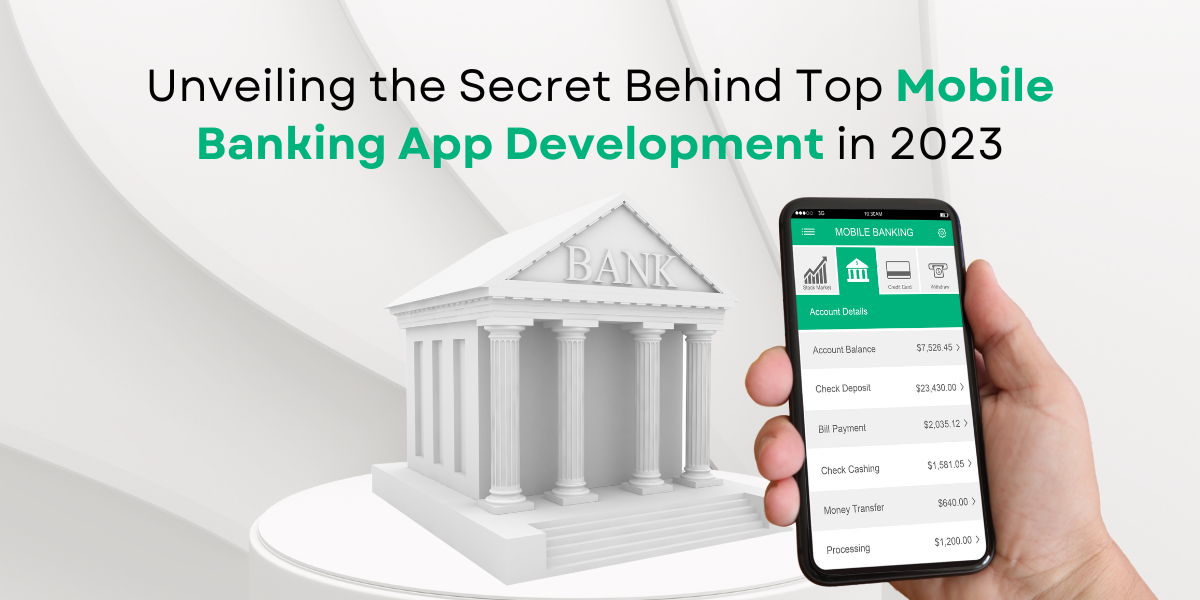
Unveiling the Secret Behind Top Mobile Banking App Development in 2023
- By Milan Panchasara
- 11-09-2023
- Mobile App Development
The technological revolutions in the world have extensively affected your lifestyle. Now, people prefer to do shopping, meetings, matrimony, banking operations, and so on through digital platforms. Online transformation is an ever-lasting trend that has insisted every industry build a digital presence.
To make your business expand to global customers, you have to go above and beyond the brick-and-mortar store. Similarly, in the banking industry, merely your bank branch couldn’t effectively increase your scope. Creating a banking app is an essential and beneficial way to take a great leap.
In this article, you will learn mobile banking trends, successful features, and a guide on how to create a mobile banking app. After all that, we have secret solutions that will work as additional perks for your banking app.
Why is the mobile banking app trend expanding in the market?
In the past few years, banking app development has been a widespread practice. With an increasing number of mobile app users, the banking industry is essentially making its service shift to the online platform. People also find mobile banking services reliable and secure.
Additionally, it also provides the convenience of performing banking operations from anywhere. Here are the enticing facilities that are grabbing customers' attention rapidly.
- Remotely deposits & fund transfers
- Bill settlement with just a click
- Easily review transaction history & details
- Accessible 24/7
- Quick loan repayments
- Improved security and so on.
So, providing these perks to customers is making mobile banking apps booming exceptionally. Well-established banks such as Ally Bank, Revolut, Chime, Varo, etc, are also responsible for the growing demand for mobile banking applications.
However, the major reason for their popularity is offering advanced features for mobile banking. As the leading banks, they offered flexibility to users of banking solutions with just a matter of clicks. It eliminates the need to visit physical bank branches. Customers can get the banking services delivered to their mobile screen only.
In a nutshell, traditional banking solutions need to revitalize their approach. So, for that mobile banking app development is the better way.
Before starting with the app development process, you need to figure out the key features. It helps you to showcase your app uniquely in the market.
Key Features for Successful Mobile Banking Application
-
eKYC
For any banking app, the Know Your Customer (KYC) verification process is crucial. Knowing your potential user's identity and verifying their ID proof is the precondition for banks. So, ensure to add an e-KYC feature to your banking app.
Consequently, it prevents the necessity for customers to visit the branch or send any representative to collect documents. The customers can easily perform the process according to the regulations in the app only.
-
User Profiles
After downloading the application, the first and most important aspect is allowing users to register their identity. The users easily navigate through the app and create their profiles. After completing the KYC, it is good to provide customers to proceed with profile creation smoothly.
The banking app should allow users to sign in with a mobile number or email address and generate their unique password or pin. It allows the accessibility of applications to the authorized user. Therefore, generating a user profile is the required feature for any banking app to keep transactions secure.
-
Biometric Authentication
Security is the ultimate factor that the app should consider at every stage of the banking operations of the user. Similarly, the app should be protected with a multi-factor authentication process. It is also a relevant aspect to gain the trust of the customers.
Providing biometric authentication for opening an app is effective and safer than passwords. So, only the user whose face recognition or fingerprint match can access the application. As per the reports, biometric authentication will secure above $3 trillion in payment transactions by 2025. The biometric feature apparently delivers a highly secure application.
-
Chatbot support
Optimized customer experience is the topmost requirement for banking applications. Any visitor should be left with confusion or questions regarding your banking services. For doing so, implementing a chatbot help desk is a great option.
Chatbot is the quick solution for the queries of the visitors and impacts in turning them into potential customers. It fills the communication gap between the bank and customers. So, customers can get assistance and support 24/7 on the app.
-
QR Code Scanner
QR code payments have undoubtedly transformed the habits of purchases and payments made earlier. It is the on-demand feature for banking apps these days. After all, users get the ease of utilizing their bank apps for QR payments rather than depending on other online payment apps.
In addition to that, it is beneficial to keep records of overall expenditures accurately. Users don’t need to rely on other payment platforms anymore.
-
Voice Banking Facility
Voice banking is altogether a new feature that is less known in the market. If you enable this new feature in your app, it will definitely assist in streamlining the app journey. Customers with nil knowledge of mobile banking can easily perform their tasks with voice assistance.
However, it first needs the customer to authenticate the voice. From performing transactions to checking balances, every detail of the banking operation will be available through the voice assistance facility.
-
Account management
The main purpose of the banking app is to offer online banking solutions to users for account management. Your app users need to provide proper reports of their accounts. It allows them to manage tasks;
- Opening & closing of the account
- Card and Passbook management
- Records transaction history
- Tracks money transfers
- Real-time balance checks
- Analyze your transaction habits, etc.
So, by leveraging the account management feature you can efficiently operate your banking app and set the financial goals accordingly. However, analyzing your financial activity app should also recommend the investment and savings plan to users.
How to Create a Banking App? 8 Necessary Steps to build a banking app
Now, the next and most important section is to turn your app development project into reality. The process of mobile banking app development is extremely critical. You have to plan and execute them thoroughly. However, the process can get simplified with correct decision-making. So, let's dive into that.
1. Thorough market research
Performing market research is the foremost step to analyzing market trends and making your action plan. The research is the broader scope of understanding your competitors, app development methodologies, user behavior, and industry dynamism. So, you can prepare your value proposition and determine the correct business model.
2. Make your security measures
Ensuring the security measures of the app is a major step. You have to look for solid security compliance. The app will consist of sensitive data, and any malware or data loss will adversely affect your bank's reputation. To build customer loyalty, it is necessary to decide upon authentic security patches well in advance.
3. Plan your UI/UX design
The design and app layout of the banking app is required to be determined strategically. Like, the logo of your bank and the overall appearance of the application should be correlated with each other. The Alfa Bank of Russia is one of the best inspirations for planning your banking app’s design.
Offering an easy-to-use and smooth navigational design allows users to operate the app efficiently. You can also get assistance from application designers and developers. The experts will provide you with better insights.
4. Prepare your prototype
The prototyping is the stage that combines your idea into a logical product structure that builds with minimal features. The primary purpose of doing so is to ascertain the sustainability and success metrics.
Develop a mobile banking app with the basic design and content. It effectively showcases your app’s functionality to the customers As a result, they can share their genuine feedback.
Usually, the development team builds MVP (minimum viable product). Therefore, you will get a clear picture of your app functionality and the major areas of improvement.
Note: The fixing and modification in the prototype product is way lower than the development process
5. Finalize the tech stack
You need to consider the right technology stack for creating mobile banking apps. No set of technology fits all banking apps. Based on your target audience and budget, the technology stack can be finalized.
For instance, if you want to attract iOS users only, the iOS platform is preferable for app development. Strategically choosing the tech stack also results in less development time and rapid marketing scope.
6. Develop the banking app
Now, the development process should be started, and for that, you need to hire fintech app developers. You can look for dedicated resources on online talent marketplaces. Remember to select the app development team from the expert IT companies. The relevant experience is an influential factor in building cutting-edge banking applications.
7. Testing & Deployment
Once the development process is completed, the quality testing process initiates. It incorporates bug detection, errors in coding, the responsiveness of the app, etc. Testing of the app needs to be performed extensively without any negligence.
With that, the deployment of the application is done. The experienced development team ensures smooth deployment and effortless user interaction.
8. Marketing your app
Once your app is submitted to the Google Play Store and Apple’s App Store, begin with your marketing strategies. Furthermore, promoting your banking app launch on social media platforms is a good technique. You can also choose a paid marketing campaign for instant results.
Do you know? Around 77% of people who read consider reading at least 1 review before downloading a free app and it extends to 80% for paid apps. So, plan to gain high ratings and reviews on the app stores.
Moreover, every new app needs to take a boost for more traffic and digital marketing is an effective way for it. You can outsource digital marketing services to build your banking brand.
4 Mobile Banking App Trends in 2023 & Beyond
Your banking app is ready to perform in the market, however, there are some trends. No matter how robust a banking app you build, upgrades and new market updates are continuous requirements. To stand out your banking app from the crowd, you can integrate the following features or solutions.
It's not necessary to put them from the beginning. As it will extend your budget. But after getting recognition and a good customer base, you should definitely reward your customers. Implementing these new-age technical solutions helps in increasing customer experience.
1. Open Banking
Adapting to open banking permits the parties to access customer data. Using the APIs and getting the customer consent for data usage, third parties can build new and advanced applications. On a wider note, open banking is not opening up the customer data for anybody to access. It allows you to modify the business model of your app.
However, it is majorly essential to enhance customer service and deliver personalized experiences. It also generates revenue sources from different providers.
2. Gamification
Gamification deals with rewarding customers with some additional benefits. They will get a chance to win cashback, vouchers, discounts, etc. through playing games and making payments with the app. Moreover, it works greatly to improve the overall session duration of users on your mobile app.
3. Cardless ATM withdrawals
Offering your customers to manage ATM withdrawals without the hassle of carrying cards. It is a popular feature that reputed banks like Wells Fargo and Bank of America already provide. So, to make your app future-ready, implement cardless ATM withdrawals for customers.
4. Digital-only banks
Physical banks have completely transformed into online banking and digital platforms. The era of virtual banks without any branches is increasing. Due to the implementation of blockchain technology, you can now build digital-only banks. It is a mobile banking app that is full-fledged and performs all banking operations.
Digital-only banks enable cloud-based solutions to establish secure networks and work on a real-time basis. So, with blockchain technology, you can upgrade your banking app to a greater scope.
How Much Does it Cost to Develop a Banking App in 2023?
The cost of developing banking applications is derived through the following factors;
- Timeframe
- Technology stack
- Set of Features
- Outsourcing Company
- Hourly rate of developers
- The complexity of the application
However, after evaluating these factors the cost to develop a banking app would range between $20,000 to $60,000 or beyond. It may increase with the integration of advanced features and the latest technology solutions.
Key Takeaways
The digital transformation has immensely influenced the banking sector. Consequently, building a mobile banking app is the need of the hour. Your traditional bank’s online entity will determine its future success in the future market. So, ensure you consider all-inclusive aspects of your banking app development. Consider hiring a top-rated app development company for your project!
Recent blog

Harnessing Social Media: Tactics For Powerful Marketing Success Achievement
Social Media | 25-07-2024
7 Hidden Secrets of MSI Laptop Boot Menu Key
Technology | 24-07-2024




